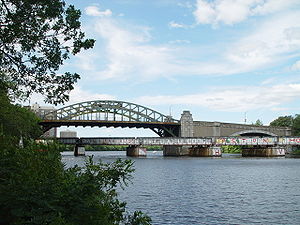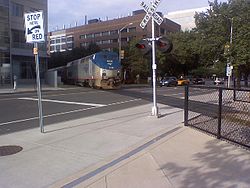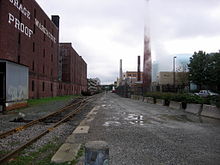- Grand Junction Railroad and Depot Company
-
The Grand Junction Railroad is an 8.55-mile (13.76 km) long railroad in the Boston, Massachusetts area, connecting the railroads heading west and north from Boston. Most of it is still in use, carrying freight to the Chelsea Produce Market,[1] and non-revenue transfers of Amtrak and MBTA passenger equipment between the lines terminating at North Station and South Station.
Contents
History
The railroad (full name Grand Junction Railroad and Depot Company) was chartered April 24, 1847 to connect the railroads entering Boston from the north and west with its wharves in East Boston. This was a rechartering of the Chelsea Branch Railroad, incorporated April 10, 1846.
The first section to open was from East Boston to the Boston and Maine Railroad in Somerville, opened in 1849. It began at a huge waterfront yard complex on Boston Harbor, occupying the space east of the Eastern Railroad terminal and west of the Boston, Revere Beach and Lynn Railroad terminal. The line headed north with two tracks (minimum) just east of the Eastern Railroad's line, crossing at-grade and splitting to the west just south of Curtis Street, with a crossover track between the two lines south of the crossing (allowing Eastern Railroad trains from their terminal to use the Grand Junction). In 1905, the Grand Junction Railroad in East Boston was rebuilt into a below-grade two-track line, and the Eastern Railroad line was truncated to just north of the split.
Next the Grand Junction crossed Chelsea Creek into Chelsea. It passed north of downtown Chelsea and through outlying areas of Everett before crossing the Mystic River into Somerville and running along the east side of the Boston and Maine Railroad's main line towards Boston. It soon crossed the border into Charlestown, part of Boston. Just south of Cambridge Street, the Grand Junction junctioned with and crossed the B&M. After crossing the B&M, the extension immediately crossed the Mystic River Branch of the Boston and Lowell Railroad, just before crossing back into Somerville. In Cambridge it crossed under the old B&L mainline (with track connections) and merged with the Fitchburg Railroad.
 The Grand Junction Railroad Bridge crosses the Charles River underneath the Boston University Bridge.
The Grand Junction Railroad Bridge crosses the Charles River underneath the Boston University Bridge.
In March 1852 the line was leased to the Eastern Railroad between the B&M in Somerville and Salem Turnpike (now called Broadway) in Chelsea. The Eastern Railroad, then ending in East Boston, used the line for downtown Boston access, building a cutoff in 1854 from their main line to the Grand Junction in Chelsea, and building a new line splitting from the Grand Junction just west of the B&M and B&L Mystic River Branch crossing and running just west of the B&M into downtown. The Saugus Branch Railroad, bought by the Eastern April 30, 1852, was realigned in 1855 at its south end to feed into the Grand Junction rather than the B&M.
The rest of the line was built in 1856, connecting to the Boston and Worcester Railroad in Allston, now part of Boston. Instead of merging with the Fitchburg Railroad, it continued west along its north side for a bit (passing under the Boston and Lowell Railroad's new alignment) before turning south, crossing the Fitchburg Railroad at-grade onto its own alignment through Cambridge. A track connection was provided with the Fitchburg Railroad, connecting the East Boston-bound Grand Junction to the Fitchburg-bound Fitchburg.
After running through Cambridge along what was once the shore of the Charles River and is now a rough border between the main campus of the Massachusetts Institute of Technology and the rest of Cambridge, the line crossed the river diagonally on a bridge under the Essex Street Bridge (now the Boston University Bridge) and joined with the Boston and Worcester Railroad (after 1867, the Boston and Albany Railroad).
The line was reorganized as the East Boston Freight Railroad in 1862, and the Boston and Albany bought the property in 1869. It passed with the B&A into larger companies - the New York Central Railroad, Penn Central and Conrail. On February 28, 1955 the counterweight fell off the Chelsea Creek drawbridge, taking the bridge permanently out of service; subsequently B&A trains reached East Boston from Chelsea using B&M trackage rights via Revere. B&A service to East Boston ended around 1972.
A small footnote is the Union Railroad, which was incorporated May 10, 1848 for the same purpose, and was authorized to merge with the Grand Junction February 25, 1854.
Current status
The line is currently owned by the MBTA and controlled by the MBCR dispatcher (see MBCR Bulletin 8-41c). Prior to June 17, 2010, the line was owned by CSX Transportation,[2] except for the East Boston section, which Guilford Rail System uses (since reconnected to the old Eastern Railroad East Boston line). MIT owns a section of the right-of-way in Cambridge from a point west of Pacific Street to Broadway, with an easement granted to CSX. The section of the line formerly used by the Eastern through Somerville, Everett and Chelsea is now used by the MBTA's Newburyport/Rockport Line, and the line west of there is used by the MBTA to bring Commuter Rail trains between the two halves of its system, in lieu of a North-South Rail Link, and by CSX to haul freight (a daily produce train to the Chelsea Produce Market). It is also used by Amtrak to transfer its equipment for the Downeaster from North Station to the Amtrak maintenance facility at Southampton Street in Boston.
In September 2009, the Commonwealth of Massachusetts finalized[2] an agreement to purchase several CSX rail lines in eastern Massachusetts, including the Grand Junction tracks from the Beacon Park Yard in Allston, through Cambridge.[3] The deal was closed on June 17, 2010.[4]
The Barnum and Bailey Circus train often parks on the Grand Junction while the circus is in Boston.
Proposals
The City of Cambridge has done a feasibility study concerning adding a "rail with trail" multi-use path from the Charles River Bike Paths at the Boston University Bridge, through MIT, paralleling Cardinal Medeiros Way northeast of Kendall Square, and connecting to the proposed extension of the Somerville Community Path near Twin City Plaza.[5]
The "locally preferred alternative"[citation needed] for the Urban Ring project as of June 2008 calls for routing bus rapid transit along the Grand Junction right-of-way, from George Washington Park in Cambridgeport, over the Charles River. The existing railroad bridge would be widened to add lanes for buses and the path.
In 2010, Lieutenant Governor Tim Murray publicly discussed branching the Framingham/Worcester Line over the Grand Junction to provide MBTA Commuter Rail service from Worcester to North Station.[6][7]
References
Notes
- ^ < "NEW ENGLAND PRODUCE CENTER, INC.". 1A Holdings Inc.. 26 October 2009. http://www.terminalmarkets.com/neweng.htm<. Retrieved 4 September 2011.
- ^ a b "Lt. Governor: Historic CSX Rail Agreement". MassDOT. 23 September 2009. http://www.bostonmpo.org/bostonmpo/resources/CMS/cmscr.htm. Retrieved 4 September 2011.
- ^ "PATRICK-MURRAY ADMINISTRATION FINALIZES AGREEMENT WITH CSX TRANSPORTATION". Office of the Governor of Massachusetts. 23 September 2009. http://www.mass.gov/?pageID=gov3pressrelease&L=3&L0=Home&L1=Our+Team&L2=Lieutenant+Governor+Timothy+P.+Murray&sid=Agov3&b=pressrelease&f=092309_CSX_transportation&csid=Agov3. Retrieved 4 September 2011.
- ^ [1]
- ^ "Grand Junction Rail-With-Trail Feasibility Study". The Department of Cambridge Community Development. http://www.cambridgema.gov/CDD/et/infra/gj/gj.html. Retrieved 4 September 2011.
- ^ Dyer, John (16 June 2010). "Much is Riding on Worcester Rail Deal". Boston Globe. http://www.boston.com/news/local/massachusetts/articles/2010/06/16/much_is_riding_on_worcester_rail_deal/. Retrieved 11 October 2011.
- ^ Moskowitz, Eric (9 August 2010). "Signals crossed on Worcester link". Boston Globe. http://www.boston.com/news/local/massachusetts/articles/2010/08/09/signals_crossed_on_worcester_link/. Retrieved 4 September 2010.
Bibliography
- Various Sanborn maps
- Ronald Dale Karr, The Rail Lines of Southern New England: A Handbook of Railroad History, ISBN 0-942147-02-2
External links
Categories:- Defunct Massachusetts railroads
- MBTA Commuter Rail
- Boston and Albany Railroad lines
- Companies affiliated with the Boston and Albany Railroad
- Predecessors of the New York Central Railroad
- Railway companies established in 1847
- Railway companies disestablished in 1862
Wikimedia Foundation. 2010.



